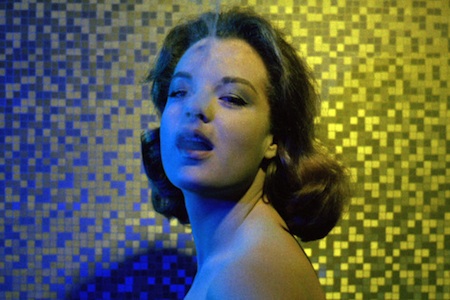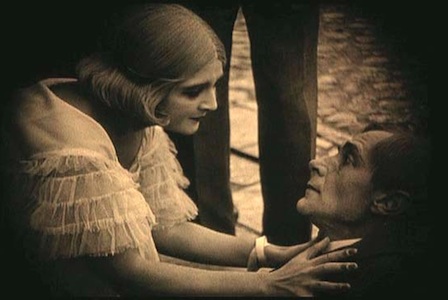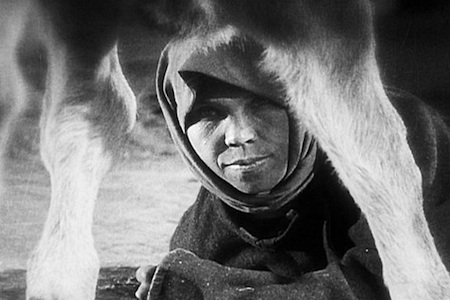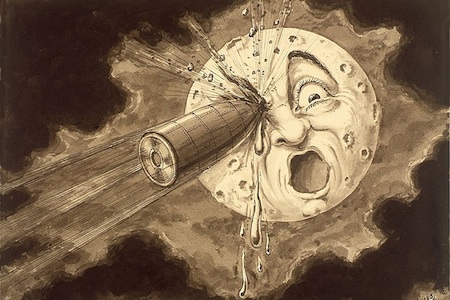Ten years ago, a small upstart company released a deluxe DVD edition of Lewis Milestone’s 1928 silent drama The Garden of Eden. This marked the birth of Flicker Alley, the brainchild of cinephile Jeff Masino, a lifelong movie-obsessive who entered the world of DVD publishing after a career in philanthropic fundraising. After a decade, Masino’s Flicker Alley is still a small organization with just two employees at its Hollywood office (located at the historic Crossroads of the World). But with a myriad of illustrious collaborative partners, his company has produced some of the most vital DVD editions of silent films in the world, as diligently restored and re-scored, and as handsomely packaged as any in the marketplace.
No film aficionado’s collection is complete without Flicker Alley’s five-disc, 173-film set Georges Méliès: First Wizard of Cinema, and its follow-up Georges Méliès: Encore. Ditto for the four-disc Chaplin at Keystone set, which covers every extant film the comedy maestro made at Mack Sennett‘s studio from his screen debut Making a Living to the feature-length Tillie’s Punctured Romance. It’s a monumental collection that proves that within his first year of filmmaking Chaplin had mastered the essential elements of his character and directing style, by showcasing it in the best possible print restorations and with a diverse range of appropriate musical scores from the best silent film accompanists in the business.
Sets paying tribute Rudolph Valentino, Douglas Fairbanks and John Gilbert are musts for fans of these respective stars, and foreign filmmakers such as Louis Feuillade (Judex), F.W. Murnau (Phantom) and Rene Clair (The Italian Straw Hat) add international flair to the Flicker Alley line. Soviet silent films are represented by the serial Miss Mend and an eight-film collection of key works by the likes of Sergei Eisenstein, Dziga Vertov, Lev Kuleshov and Esther Shub. Recently, Flicker Alley has begun branching into talkies with Merian C. Cooper and Ernest P. Shoedsack’s warm-up for King Kong, The Most Dangerous Game, the documentary Gow, and a pair of Cinerama spectaculars, This Is Cinerama and Windjammer: the Voyage of Christian Radich.
I recently spoke with Jeff Masino by phone, beginning by rattling off some of my favorites of his publishing accomplishments. He was quick to spread my praise to his co-conspirators:
Jeff Masino: I do not do this alone. My success is reflected glory. The films speak for themselves. Many historians and collectors and archivists have gone before me, and go into certain projects with me, so I [alone] certainly can’t take credit for success.
Keyframe: You’ve formed alliances with many titans of today’s film history and archiving world. How have these come about?
Masino: Speaking of Kevin Brownlow and David Shepherd, two titan film historians in particular, it really came out of their passion for cinema, and desire to share knowledge with others. This extended to, back in the day, helping a newbie such as myself with business points, with historical points. I’ve seen them be incredibly generous with their time with other colleagues as well, and it’s really great to see. Beyond David and Kevin, there have been a whole host of other people with archives, with Lobster films. People who have gone before me in business like Dennis Doros and Amy Heller at Milestone Films. My own partnerships initially were with the Library of Moving Images here in Los Angeles, and Robert Israel, the composer I’ve worked with on many projects. They, too, were very generous with their time and very open to working with someone like me when I first started out.
Keyframe: I’m particularly curious about that ‘first started out’ moment.
Masino: I’ve always loved and been fascinated by films and film history, and when I was a kid I had a 35mm camera that I got to play with, with slide film. That moved into actually starting to play with Super 8 film cameras and collecting Super 8 films.
After my mom died when I was 12, I had a period of going and looking at family films; 8mm films. That led to somehow discovering the whole Blackhawk collection, and what they were making available on 8mm.
Keyframe: Blackhawk was a company out of Iowa that distributed small-gauge films for the home collector market. Wasn’t David Shepherd involved with them?
Masino: David Shepherd was at Blackhawk. Basically, my choices were what could I afford. I couldn’t afford more than a 200-foot reel of 8mm film on sale in the Blackhawk Bulletin. So I would buy things like The Battle of the Century pie fight with Laurel and Hardy, because that was a 200-foot reel and not a 400-foot reel of film. A Trip to the Moon is (I love to say this) the very first 8mm Blackhawk Bulletin film that I bought from them.
Keyframe: And now you’ve done so much with that film…
Masino: Now I’ve done so much with the publishing of that film. Lobster Films, Eric Lange and Serge Bromberg and Technicolor and the Groupama Gan Foundation—they’ve done a lot with that film. I’ve come full circle, and have been able to benefit from their work in terms of distributing the new restoration, but before that, Eric and David and Serge would be collecting and restoring the films of George Méliès for probably a decade before that.
Fifteen, eighteen years ago, I was working where my office is now, here at Crossroads of the World. It’s where Michael Yakaitis had the Library of Moving Images. I had approached another early champion of my efforts, Michael Friend, who was at the Academy Film Archive back then. I had wanted to do something entrepreneurial with experimental and independent filmmakers that were still alive and did a lot of work in the ’50s and ’60s and ’70s. There were film co-ops and there was Canyon Cinema. I didn’t see a lot of those works published [on DVD], and there are a number of reasons for that. In many cases the filmmakers didn’t want their works presented that way. It was dubious what kind of market there would be, unfortunately. Anyway the National Film Preservation Foundation has come through with their Treasures IV DVD set, and subsequently some of this stuff has shown up on home video. I think that’s fantastic, and they are the right people to do those types of publications. But when I was first starting out, it quickly became apparent that it wouldn’t really be commercial, so I looked at the lead of others. I looked at what David Shepherd was doing with Film Preservation Associates through Image Entertainment, and what Milestone Film & Video was doing, and what Kino on Video (now Kino Lorber) was doing at the time.
Keyframe: These days more home video connoisseurs are focused on high-definition rather than traditional standard-definiton DVD. You’ve released a few titles on Blu-Ray including Henri Georges-Clouzot’s Inferno and The Most Dangerous Game. Your new Cinerama releases seem particularly suited for Blu-Ray. But so far, you haven’t released many silent films in the format.
Masino: It’s just a matter of what kind of projects I could afford to take on, and what kind of masters were available for me to use. Some of these projects only come about, with the scores and whatnot, because of the partnership of another huge supporter that I also should have mentioned right at the outset: Turner Entertainment Networks. In particular Charlie Tabesh and his colleagues at Turner Classic Movies, who have been very supportive of me back from the beginning as well. Some of these things only come about with their blessing and involvement. In the case of Miss Mend, it’s a 250 minute serial. To master something like that and to do the kind of score that Robert Israel was gonna do, we needed someone like Turner involved. We mastered it in SD, and that was what was most readily available to publish it. Even though it was just four years ago, a lot’s changed. Only in the last year or two, at the scale where I operate my business, it’s become viable to actually master things in HD and publish them in HD. I wish I had the financial ability to do more dual releases. The companies that I look up to are able to do that and that’s great. I have to be more selective. That being said, there are definitely more Blu-Ray editions in the works. I wish I could do everything in Blu-Ray. There are certain partners we’re working with where the masters are still only being provided in SD, but I’m hoping that’s moving more and more into an HD-only world where I’ll be able to afford to do more Blu-Ray publishing as well.
Keyframe: How are the musicians chosen to provide scores for your silent film releases? Is it you or your partners who commissions and records these?
Masino: It really depends on the project. When I got involved with the Méliès project, it was still fairly early on in the partnership with Film Preservation Associates and Lobster Films, so they were already in the process of commissioning those scores for that set. When they’ve been things that involve Turner Entertainment Networks I have a say in bringing the musicians. I’ve been loyal with Robert. We worked together on J’Accuse and we worked together on Miss Mend. There’ve been other projects where I’ve gone out independently on my own.
Keyframe: How did the Dennis James Wurlitzer organ score for The Yankee Clipper? His scores are so rarely published.
Masino: That was the relationship that Dennis and David Shepherd had. He really did a great job with that. That was at the Paramount Theatre in Seattle. He’s great. I love hearing him at the San Francisco Silent Film Festival. He played for The Mark Of Zorro this year. The Mont Alto Motion Picture Orchestra, Donald Sosin….there are a lot of great people that I’ve had the pleasure of working with.
Keyframe: One of the year’s most-discussed film history-related events has been the release of Sight & Sound’s latest poll of the top films of all time. You were asked to participate, and you were one of the small handful of people who picked, not only the poll’s #1 film from 1962-2002 (Citizen Kane) and the new #1 (Vertigo), but also the #1 choice in first poll from 1952: Bicycle Thieves.
Masino: I think when I emailed them I said, ‘This is a really arbitrary list.’ How could it not be? I know that I was thinking, shouldn’t something from Italian neorealism be represented in terms of milestones of cinema? I feel the same way about what they were doing in British films just ten years later. I think ‘kitchen sink realism’ is what they called that.
Keyframe: Does that explain your choice of Room at the Top?
Masino: I would consider it an early, seminal work in that movement, but these are just my opinions. Should it be Room at the Top or should it be The Innocents? Or should it be A Kind of Loving, or The Loneliness of the Long Distance Runner? What do you choose? They just become signposts of a movement.
Keyframe: You put Napoléon on your ballot, and you’ve worked on Gance films.
Masino: I just recently saw Napoléon thanks to Kevin Brownlow and the San Francisco Silent Film Festival, and others, in Oakland, so that was fresh in my mind.
Keyframe: You cited Trip to the Moon, which obviously has that personal connection we already talked about.
Masino: Like I said, it was the first film I personally ever collected, and I collected it because it was famous and it dealt with fantasy and science fiction. To a kid that was really appealing, and it’s been a part of my life. The more I’ve gone through life I’ve realized what an important film it was on so many levels. How could it not be considered one of the greatest films of all time? Even if I did publish the most recent restoration of it.
Keyframe: Were there any other films you collected as a kid that you’ve been able to release through Flicker Alley?
Masino: That’s a great question. Nothing comes to mind. If they were 8mm films and they were silent….
Keyframe: You didn’t order any Soviet avant-garde works?
Masino: I’m sure that Blackhawk offered them. I’m sure they had Potemkin. And probably Earth. Wouldn’t that have been around at the time? And Storm Over Asia… I’m sure that different versions of these films have endured, because they’re so brilliant. But no, as kid I did not. Those would’ve been too expensive for me to be able to afford.
Keyframe: One more question. Before you founded Flicker Alley you were in the world of for-profit philanthropy.
Masino: I was. I worked with Palotta Teamworks, the California AIDS Ride and the Avon Breast Cancer three-day walks, which were fundraising events for HIV and AIDS services here in California and for Breast Cancer research.
Keyframe: Not that life-saving services and cinephilia are equivalent, but somehow it seems like Flicker Alley is a form of philanthropy for our moving image heritage. From the way I understand your role in the AIDS Ride you helped inspire people to bring a lot to the table to create a larger thing.
Masino: They did. There are correlations. I was fortunate in that the success I had with those fundraising efforts was due to the work of dozens if not hundreds of volunteers that felt passionately about the work that the San Francisco AIDS Foundation was doing and that the Jeffrey Goodman Clinic at the L.A. Gay & Lesbian Center was doing—that these organizations still are doing. Working with people who feel passionate about something definitely bridges both careers.
I’ve thought of setting up Flicker Alley as a not-for-profit 501(c)(3). I would have a board and I would have a mission that would be involved with bringing film history to new audiences. Instead of of bringing HIV and AIDS services to those in need, it would bring film history to new audiences as a way of cultural education. I made the decision not to do that. But that’s certainly one way you could look at those parts of my life… my career.
I’m really proud of that work, and those events have survived. They’re named something else now. The Center does it in-house with the AIDS foundation of San Francisco now. But the events are still important, though I have not ridden one or been directly involved since my time starting Flicker Alley, as this company has pretty much consumed the last ten years of my life.
If I look ahead, I love the idea of maybe, again going back to Kevin Brownlow and David Shepherd, looking at teaching how cinema has influenced history. And that ties back to the work that film archivists do. They’re not just technicians. They feel passionate about history—film history in particular, but I think generally passionate about history, and about what the past can teach us. I think you need that motivation to do to go through one of the programs at UCLA or George Eastman House or NYU, and to do this kind of work. So, once again, I’m thankful for the people that are getting into it and who continue to do it, because, like me, they are really inspired by how film history can illuminate and enrich our lives now.







